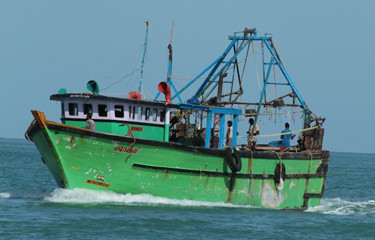The issue of Indian fishermen using Kachchatheevu Island as a base for their trawling industry has been a longstanding concern for Sri Lanka, posing a significant threat to our marine resources. Despite numerous discussions and declarations, the trawling activities persist, driven by powerful business interests. For over 50 years, the Indian trawling industry has utilized Kachchatheevu Island as a center for their operations, depleting marine resources and disrupting the livelihoods of local fishermen. The need to address this issue has never been more urgent.
One potential solution is to introduce regulated trawling to the people of Jaffna. The northern sea, relatively shallow, is unsuitable for deep-sea fishing techniques such as long-line fishing. However, the region is rich in shrimp, lobsters etc. both large and small, which can significantly boost the national economy. Introducing trawling to Jaffna could benefit both the local economy and the overall economy of the country. By adopting regulated trawling practices, Jaffna fishermen could efficiently harvest shrimp, providing them with a new source of income.
The current ban on trawling in Sri Lanka has hindered the potential growth of the local shrimp industry, unlike in other countries where trawling is regulated rather than prohibited. Many countries worldwide have not banned trawling; instead, they manage the industry by dividing the fishing areas. In Sri Lanka, an initiative by Canadian organization in collaboration with NARA, reserved an area south of Mannar for trawling. Unfortunately, this recommendations was canceled and trawling is banned , missing an opportunity for regulated and sustainable trawling.
When crafting regulations regarding trawling, it is crucial to specify guidelines clearly. One approach to mitigate the issue is to eliminate Indian interference by encouraging Sri Lankan fishermen to engage in regulated trawling. This transition would ensure that local fishermen benefit from the practice while preserving marine resources.
Alternatively, a collaborative effort with India could be established, where both countries monitor and regulate the trawling activities. India’s shrimp industry earns approximately $2 billion annually from the exports ,contributing significantly to their total fisheries revenue of about $8 billion. In contrast, Sri Lanka’s total fishing income from exports is about $300 million. Given our abundant marine resources, it is disheartening to see such a disparity. By adopting a balanced and cooperative approach, Sri Lanka can protect its marine resources while enhancing the economic well-being of its fishermen.
Therefore, it is crucial to address the Kachchatheevu and trawling issues separately. While the sovereignty of Kachchatheevu remains a distinct concern, the issue of trawling requires focused attention as a separate matter. Both Sri Lanka and India must acknowledge this distinction to facilitate a more straightforward resolution. By treating trawling as an independent issue, both countries can engage in constructive dialogue and implement effective measures to mitigate its impact on marine resources and local livelihoods. This approach is essential for fostering mutual understanding and achieving sustainable solutions that benefit all stakeholders involved.
Ayesh Indranath Ranawaka
Executive Director INORA- Institute of Ocean Resources Analysis
ocean 1 st by oceanlust






Leave a Reply